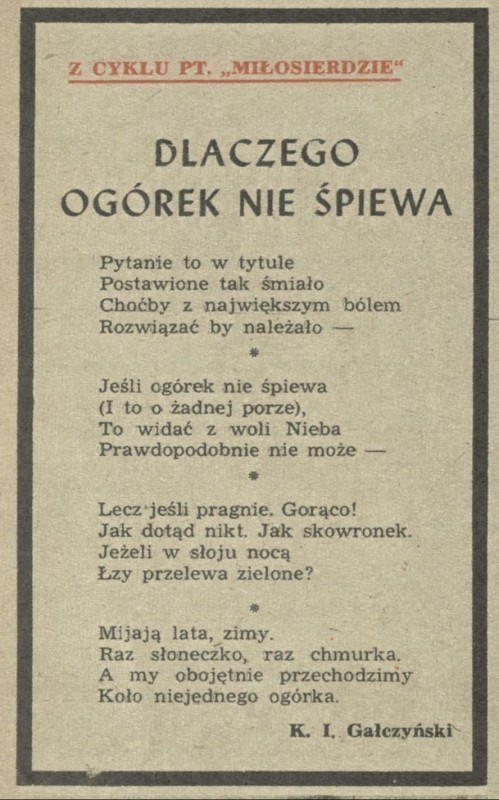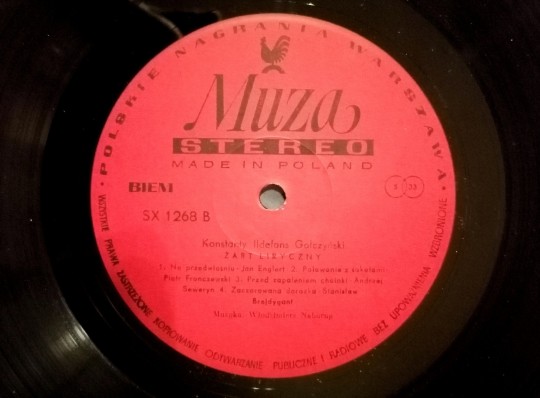#galczynski
Explore tagged Tumblr posts
Text
Konstanty Ildefons Gałczyński
WHY DOES THE PICKLE NEVER SING
The question that our title has cast in deathless bronze is painful yet so vital, we owe it a response.
If our little green friend won't sing, croon, lilt or chant, it's clear that, Heaven forfend, it most probably can't.
But what if evil stars trample its throat? If divine airs die in air-tight jars, engulfed by teary brine?
Meanwhile, time flies, alas first sunshine, then rains trickle, and still we callously pass by many a pained pickle.
1953
[Translated by S. Barańczak and C. Cavanagh]
🥒 🥒 🥒 🥒 🥒 🥒 🥒 🥒

1947
#one of my favorite poems I wanted to share with you#dlaczego ogórek nie śpiewa#why does the pickle never sing#Konstanty Ildefons Gałczyński#Gałczyński#galczynski#konstanty ildefons galczynski#polish poetry#poetry#I loved this poem for 20 years at least#yet thinking just now how I sympathise with a random being that can't sing no matter how much it desires to...#it's like forever desiring to experience something that could never happen#quite aroace I'd say...#polish poem#polska poezja#polska
8 notes
·
View notes
Text

The Slovakian Tatras
The Night In A Mountain Hostel Near Popradske Pleso
By Michał Gałczyński
#michal galczynski#photographer#slovakian tatras#mountains#forest#night sky#landscape#popradske pleso#nature
32 notes
·
View notes
Text



Konstanty Ildefons GAŁCZYŃSKI
"Liryka / Żart liryczny"
(LP. Polskie Nagrania Muza. ?) [PL]
#Konstanty Ildefons GAŁCZYŃSKI “Liryka / Żart liryczny”(LP. Polskie Nagrania Muza. ?) [PL]#konstanty ildefons galczynski#spoken word#poetry#open jazz#records#poland
5 notes
·
View notes
Text
Why wait for a PhD, Masters thesis not good enough? Polish poet Konstanty Galczynski wrote his thesis in English Philology about a totally fictional English poet from 16th Century, complete with a biography and works.

25K notes
·
View notes
Text

from https://www.boredpanda.com/weekend-slovakia-photography-michal-galczynski/
35 notes
·
View notes
Photo

Looking to get a loan or refinance? Contact Ronda Pearson Galczynski for details or assistance. https://www.instagram.com/p/Cl_6-n1OhjN/?igshid=NGJjMDIxMWI=
0 notes
Photo

Allentown, PA - Pocono Bobcats cheerleader Mary Grace Galczynski cheers on her team in the first half of a game against the Allentown A’s.
0 notes
Text
2018 Missouri Class 2 All-Region Soccer: St. Louis and Southeast Districts 1-4
2018 Missouri Class 2 All-Region Soccer: St. Louis and Southeast Districts 1-4
Lexi Lanzafame splits a pair of Cape ND defenders enroute to earning a PK in the Sectional match on May 21, 2016 The 2018 Class 2 St. Louis All-Region Soccer Team schools has been announced. Recognition for Conference, Regional and State awards is done by members of the Missouri State High School Soccer Coaches Association(MSHSSCA). 2018 Missouri Class 2 All-Region Soccer: St. Louis and…
View On WordPress
#Abby Wilson#Alaina Baumgart#Alayna Buxton#Allison Bettlach#Amanda Aug#Amanda Kopp#Arika Buxton#Bailey Beussink#Bridget Kelly#Grace Powderly#Hanna Al-Baaj#Jessica Gabel#Jordyn Spreck#Kasey Hartmann#Kaylee Freihaut#Kirstin Jannin#Lexi Lanzafame#Livia Wunderlich#Madi Galczynski#Megan Davisdon#Megan Heisserer#Miranda Pratt#Missouri Soccer Coaches Association#Paige McNiff#Zoey Vogel
0 notes
Video
youtube
Ravensbrück Concentration Camp - Ravensbrück was a women's concentration camp during World War II, located in northern Germany, 90 km north of Berlin at a site near the village of Ravensbrück (part of Fürstenberg/Havel). Construction of the camp began in November 1938 by SS leader Heinrich Himmler and was unusual in that it was a camp primarily for women and children. The camp opened in May 1939. In the spring of 1941, the SS authorities established a small men's camp adjacent to the main camp. Between 1939 and 1945, over 130,000 female prisoners passed through the Ravensbrück camp system; around 40,000 were Polish and 26,000 were Jewish. Between 15,000 and 32,000 of the total survived. Although the inmates came from every country in German-occupied Europe, the largest single national group incarcerated in the camp consisted of Polish women. Siemens & Halske employed many of the slave labor prisoners. The first prisoners at Ravensbrück were approximately 900 women. The SS had transferred these prisoners from the Lichtenburg women's concentration camp in Saxony in May 1939. By the end of 1942, the inmate population of Ravensbrück had grown to about 10,000. There were children in the camp as well. At first, they arrived with mothers who were Gypsies or Jews incarcerated in the camp or were born to imprisoned women. There were few of them at the time. There were a few Czech children from Lidice in July 1942. Later the children in the camp represented almost all nations of Europe occupied by Germany. Between April and October 1944 their number increased considerably, consisting of two groups. One group was composed of Roma children with their mothers or sisters brought into the camp after the Roma camp in Auschwitz-Birkenau was closed. The other group included mostly children who were brought with Polish mothers sent to Ravensbrück after the collapse of the Warsaw Uprising of 1944. With a few exceptions all these children died of starvation. Ravensbrück had 70 sub-camps used for slave labour that were spread across an area from the Baltic Sea to Bavaria. Among the thousands executed by the Germans at Ravensbrück were four female members of the British World War II organization Special Operations Executive: Denise Bloch, Cecily Lefort, Lilian Rolfe and Violette Szabo. Other victims included the Roman Catholic nun Élise Rivet, Elisabeth de Rothschild (the only member of the Rothschild family to die in the Holocaust), Russian Orthodox nun St. Maria Skobtsova, the 25-year-old French Princess Anne de Bauffremont-Courtenay and Olga Benário, wife of the Brazilian Communist leader Luís Carlos Prestes. The largest group of executed women at the Ravensbrück camp was composed of 200 young Polish patriots who were members of the Home Army. Among the survivors of the Ravensbrück camp was Christian author and speaker Corrie ten Boom. Corrie ten Boom and her family were arrested by the Nazis for harbouring Jews in their home in Haarlem, the Netherlands. The ordeal of Corrie and her sister Betsie ten Boom in the camp is documented in her book The Hiding Place which was eventually produced as a motion picture. Countess Karolina Lanckoronska, a Polish art historian and author of Michelangelo in Ravensbruck also was imprisoned in the camp from 1943--1945. Eileen Nearne, a member of the Special Operations Executive was a prisoner in 1944 before being transferred to another work camp and escaping. Additional Ravensbruck survivors include Gemma LaGuardia Gluck - who wrote a memoir about her experiences at the camp and afterward - her daughter Yolande, and Yolande's baby son. During her imprisonment in Ravensbrück, the anthropologist and member of the French resistance Germaine Tillion secretly wrote a comic operetta about camp life titled Le Verfügbar aux Enfers. In 1975, she published a comprehensive study of the camp, Ravensbruck: An eyewitness account of a women's concentration camp. In 1945, just prior to liberation, the poet, playwright and author of The Green Goos, Konstanty Ildefons Galczynski, managed to save one of the Ravensbruck inmates from certain death. Her name was Lucyna Wolanowska. They began living together, and in January 1946 their son was born, also named Konstanty Ildefons Gałczyński. Later that same year Lucyana Wolanowska and her son emigrated to Australia. -- from Mock the Right on Facebook - bit.ly/2TKLJMe
0 notes
Text

The Slovakian Tatras
Jupiter - View From Popradske Pleso
By Michał Gałczyński
#michal galczynski#photographer#slovakian tatras#mountains#night sky#jupiter#popradske pleso#landscape#nature
21 notes
·
View notes
Photo

08-23 NEW YORK CITY, NY - MARCH 25: (L-R) Sterling Folkestad, Anna Marie Van Balit, Conrad Galczynski and Mila Filatova attend M.A.C. ... http://dlvr.it/Ph2kmP
0 notes
Quote
Years I have loved you, stay Locked in a night and a song. Maybe eight have gone away, Maybe nine — I may be wrong. Everything faded in twilight, confusion, You and me, we’re both entangled somewhere You must be revolt and surrender, and illusion And myself, I am your beauty and your hair.
— Konstanty Ildefons Galczynski (1905-1953), Years I Have Loved You, 1938
18 notes
·
View notes
Text
In your eyes shines a magic star And your heart is all of the sunbeam. Oh, I wish I could save this heart From the oblivion’s sin. Konstanty Ildefons Galczynski (Polish, 1905-1953) Russian translation: Глаза твои - два огонька, а сердце - вот исток свеченья. Я это сердце на века спасти хотел бы от забвенья. Константы Ильдефонс Галчинский (1905-1953)
4 notes
·
View notes
Quote
We śnie We śnie jesteś moja i pierwsza we śnie jestem pierwszy dla ciebie rozmawiamy o kwiatach i wierszach psach na ziemi i ptakach na niebie We śnie w lasach są jasne polany Spokój złoty i niesłychany pocałunki zielone jak paproć Albo jesteś egipska królowa jak miód słodka i mądra jak sowa a ja jestem dla ciebie jak światło.
K.I. Gałczyński
13 notes
·
View notes
Text
The Book Talks To The Disturbed by K.I. Gałczyński
If even by the spring you will be alone, when to the swallow you will be in vain explaining what bothers you, when the hardest hour indicates the clock, trace me – and you'll find me on the shelf.
I am not enormous object, but it's hard to pass me by to whom the worry happens to be the house mistress; so sit in the best chair in your flat and bend down over me, and let the eyes flow.
Then I'll spout all the rays in the eyes and I'll be your mother and consolation, and with letters you'll chat like with the stars, that I'm as small as the heart and as big as the heart.
original here: Książka mówi do stroskanego
#poem#polish poetry#Gałczyński#Galczynski#Konstanty Idefons Gałczyński#poem translation#poetry#book#disturbed#książka mówi do stroskanego
3 notes
·
View notes
